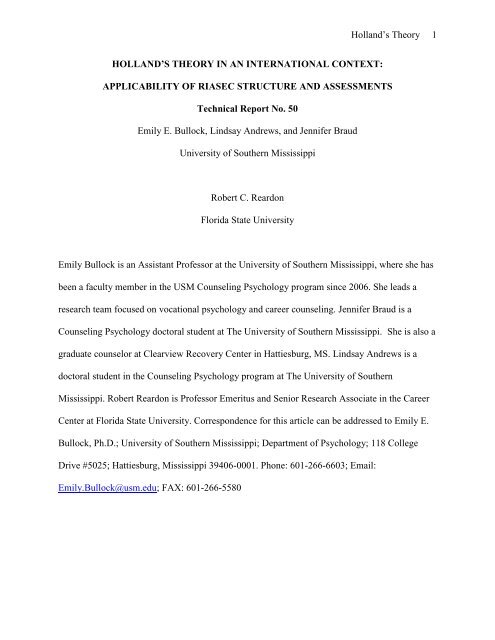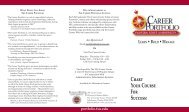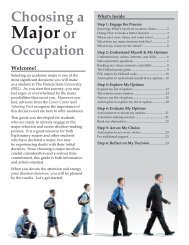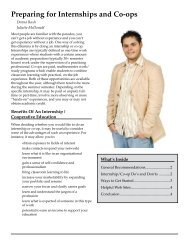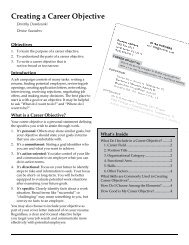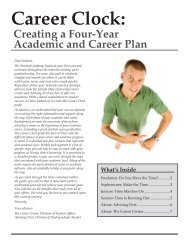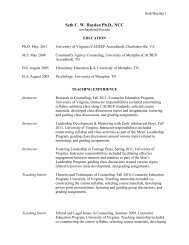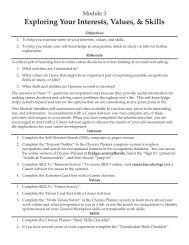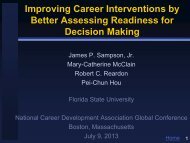Holland's Theory in a Post-Modern World: - The Career Center ...
Holland's Theory in a Post-Modern World: - The Career Center ...
Holland's Theory in a Post-Modern World: - The Career Center ...
Create successful ePaper yourself
Turn your PDF publications into a flip-book with our unique Google optimized e-Paper software.
Holland’s <strong><strong>The</strong>ory</strong> 7exams differentiate majors fall<strong>in</strong>g <strong>in</strong>to the two tracks. Similar early decisions about career tracksare seen <strong>in</strong> other countries (e.g., Šverko & Babarovic, 2006; Tak, 2004).In the follow<strong>in</strong>g section, we explore literature as it perta<strong>in</strong>s to the understand<strong>in</strong>g of thehexagonal model outside the U.S. by first describ<strong>in</strong>g some of the conceptual models that useHolland’s theory, exam<strong>in</strong><strong>in</strong>g the f<strong>in</strong>d<strong>in</strong>gs of a highly relevant meta-analysis (Rounds & Tracey,1996), and review<strong>in</strong>g relevant literature not <strong>in</strong>cluded <strong>in</strong> the Rounds and Tracey meta-analysis.Seven Holland-Related Models for the Structure of Vocational InterestsHolland’s RIASEC model has been elaborated <strong>in</strong> terms of a circular order hypothesis anda circumplex hypothesis. This was further elaborated <strong>in</strong> a schema by Prediger (1982), followedby a spherical model of <strong>in</strong>terests posed by Tracey & Rounds (1995). We will elaborate on theHolland, Prediger, Tracey and Rounds, and partition models <strong>in</strong> the follow<strong>in</strong>g paragraphs with acomment on cross cultural implications for each.Two major structural hypotheses of Holland’s model identified <strong>in</strong> the literature are (a) thecircular order hypothesis and (b) the circumplex hypothesis (Rounds, Tracey, & Hubert, 1992).<strong>The</strong> circular order hypothesis is based on the idea that the <strong>in</strong>ter-po<strong>in</strong>t distances for the six typesare “<strong>in</strong>versely proportional to the theoretical relationships between them” (Holland, 1973, 1985,p. 5). In other words, adjacent types (e.g., RI, IA, AS, SE) should have a larger correlation thanother correlations, and correlations between opposite types (e.g., RS, IE, AC) will be smallerthan all others. This circular order structure has been supported <strong>in</strong> various contexts and hasformed the basis of some of the most widely used vocational <strong>in</strong>terest assessments, many ofwhich are mentioned <strong>in</strong> the assessment portion of this article (e.g., Strong Interest Inventory;Harmon, Hansen, Borgen, & Hammer, 1994; Self-Directed Search; Holland, Fritzsche, &Powell, 1994). Rounds et al. (1992) suggest that the underly<strong>in</strong>g structure of the circular order<strong>in</strong>g
Holland’s <strong><strong>The</strong>ory</strong> 8of types is a circumplex. Similar to the circular order hypothesis, the circumplex hypothesisholds the same predictions for the relationships between types but adds that the correlationsbetween each of the adjacent types will be equal, the correlations between each of the alternatetypes will be equal, and the correlations between each of the opposite types will be equal.<strong>The</strong>re have been mixed results regard<strong>in</strong>g support for the circular structure of the RIASECmodel across cultures. Some have proposed alternative models to expla<strong>in</strong> <strong>in</strong>terests that are notaligned with Holland’s theory (Prediger, 1982; Tracey & Rounds, 1995). Rounds and Tracey(1996) used a meta-analysis to exam<strong>in</strong>e the cross cultural applicability of Holland’s hexagonalstructure.Another method for represent<strong>in</strong>g the circumplex model is Prediger’s (1982) twodimensionalschema of vocational <strong>in</strong>terests, which is an additional way to view Holland’sRIASEC hexagon. Prediger asserted that the hexagon is a multidimensional model which can bebetter represented us<strong>in</strong>g two bipolar dimensions. <strong>The</strong> two dimensions are labeled people-th<strong>in</strong>gsand ideas-data.F<strong>in</strong>ally, as an extension of this model, Tracey and Rounds (1995) proposed a thirddimension of vocational <strong>in</strong>terests which they labeled prestige. <strong>The</strong>y suggested that vocational<strong>in</strong>terests are better represented by a sphere rather than a circle and unlike the hexagonal model,types on the spherical model are not of equal distance from their neighbor<strong>in</strong>g types.For example, Liu and Rounds (2003) found <strong>in</strong> ma<strong>in</strong>land Ch<strong>in</strong>a that the distances betweenthe Realistic and Conventional types and Investigative and Artistic types were greater than otherdistances and proposed an octant model. This implies that RIASEC types are located on a circleat po<strong>in</strong>ts <strong>in</strong> an octant model but with two empty spaces on the model, between R and C and alsobetween I and A, for unspecified types.
Holland’s <strong><strong>The</strong>ory</strong> 9Two variations on Holland’s RIASEC scheme for organiz<strong>in</strong>g <strong>in</strong>terests <strong>in</strong>volvepartition<strong>in</strong>g groups of <strong>in</strong>terests <strong>in</strong> alternative arrangements. Gati (1979, 1982, 1991) proposed ahierarchical model of <strong>in</strong>terests as an alternative to Holland’s model, and suggested a three-groupmodel partition<strong>in</strong>g <strong>in</strong>terest doma<strong>in</strong>s as follows: R-I, A-S, and E-C. Gati’s model predicts that thecorrelations between RIASEC types with<strong>in</strong> a s<strong>in</strong>gle category (e.g., R and I) are greater than thecorrelations between pairs of RIASEC types outside of the category (e.g., R and A). Rounds andTracey (1996) noted problems <strong>in</strong>herent <strong>in</strong> both Holland and Gati’s model based on themagnitude of relation of the A and S types, so they formulated an alternative three-grouppartition model similar to Gati’s model which put A <strong>in</strong> its own category and S was added to theE-C category.<strong>The</strong>se three models, Holland’s (1985) circular order model, Gati’s (1982) three-grouppartition, and the Rounds and Tracey (1996) alternative three-class partition model were<strong>in</strong>cluded <strong>in</strong> Rounds and Tracey’s 1996 meta-analysis. <strong>The</strong>se models were exam<strong>in</strong>ed forstructural equivalence across cultures and were based on the literature from 1970 to 1992.Rounds and Tracey exam<strong>in</strong>ed the fit of these models us<strong>in</strong>g 96 <strong>in</strong>ternational matrices from 19countries <strong>in</strong>clud<strong>in</strong>g Australia, Brazil, Canada, Columbia, France, Guyana, Iceland, Indonesia,Israel, Malaysia, Mexico, New Zealand, Pakistan, Papua New Gu<strong>in</strong>ea, Paraguay, Portugal,Taiwan, 20 United States ethnic matrices, and a benchmark sample of 73 United States matrices.<strong>The</strong>y found that researchers varied <strong>in</strong> their methods for evaluat<strong>in</strong>g RIASEC structure <strong>in</strong>non-U.S. samples but most used one of the follow<strong>in</strong>g: U.S. RIASEC measures, adaptation ofU.S. RIASEC <strong>in</strong>ventories, theory-constructed RIASEC measures, and translated U.S. RIASECmeasures. Us<strong>in</strong>g Hubert and Arabie’s (1987) randomization, they found that regardless of theassessment method used when study<strong>in</strong>g Holland’s model <strong>in</strong> other countries, the cross-culture
Holland’s <strong><strong>The</strong>ory</strong> 10structural equivalence of Holland’s circular order model was not supported. Additionally, theyfound that Gati’s model and their alternative model (Rounds & Tracey, 1996) fit the <strong>in</strong>ternationaldata well and both fit significantly better than Holland’s circular order model.As the literature reveals, there have been numerous models posed to expla<strong>in</strong> the structureof <strong>in</strong>terest which are based on Holland’s orig<strong>in</strong>al RIASEC structure. As the review of theliterature demonstrates, these various models have also been found to be of vary<strong>in</strong>g use <strong>in</strong>different cultures. <strong>The</strong> f<strong>in</strong>d<strong>in</strong>g of the 1996 meta-analysis was not very encourag<strong>in</strong>g regard<strong>in</strong>g theuse of Holland’s traditional RIASEC model outside the U.S. Yet, research not <strong>in</strong>cluded <strong>in</strong> theRounds and Tracey (1996) study is mixed but somewhat more promis<strong>in</strong>g. We now exam<strong>in</strong>e theresearch not <strong>in</strong>cluded <strong>in</strong> their 1996 meta-analysis that has sought to expla<strong>in</strong> the structure ofvocational <strong>in</strong>terests globally.<strong>The</strong> Structure of Vocational Interests <strong>in</strong> Non U.S. SamplesS<strong>in</strong>ce Rounds and Tracey’s (1996) meta-analysis, many studies have explored the natureof the RIASEC model. Specific studies that evaluated the applicability of it <strong>in</strong> various culturesand sett<strong>in</strong>gs from 1996 to March 2008 are exam<strong>in</strong>ed <strong>in</strong> the follow<strong>in</strong>g sections. <strong>The</strong> current statusof the RIASEC model <strong>in</strong> Africa, Asia, Europe, and South America is presented. Table 1 providesa complete list of the applicability of each model by country as well as the characteristics of thesample and the measures used. <strong>The</strong> <strong>in</strong>formation <strong>in</strong> Table 1 is limited by practical space concerns,researchers’ multiple approaches, and researchers’ use of various Holland-based assessmenttools. Because this is a literature review and the authors were not limited by the statisticalconstra<strong>in</strong>ts of a meta-analysis, we chose to present all of the <strong>in</strong>formation reviewed for a morecomprehensive summary of the literature.
Holland’s <strong><strong>The</strong>ory</strong> 11----------------------------------------------------------------------------------------Insert Table 1: Source, Sample Characteristics, Inventory,Inventory Language, and Fit of Model to Data by Country Here----------------------------------------------------------------------------------------Africa. We found one study that sampled participants <strong>in</strong> Africa. In 2002, du Toit and deBru<strong>in</strong> tested the validity of Holland’s circular order model for black South African students us<strong>in</strong>gthe South African version of the Self-Directed Search. <strong>The</strong> results <strong>in</strong>dicated that the structuralvalidity of Holland’s circular order model of personality types was not supported <strong>in</strong> this SouthAfrican population. <strong>The</strong> authors argued that because black South Africans value collectivism, avalue that is contradictory to that of many Western societies, it is possible that this value affectsvocational <strong>in</strong>terests. <strong>The</strong>y also noted that the unemployment rate <strong>in</strong> this population wasextremely high and that participants may have endorsed several <strong>in</strong>terests on the SDS with thehope of <strong>in</strong>creas<strong>in</strong>g their odds for ga<strong>in</strong><strong>in</strong>g employment. It is also important to note that the SDSwas <strong>in</strong> English, a second language for many of them. Only m<strong>in</strong>imal research is available on theRIASEC structure <strong>in</strong> Africa and more research is needed to understand its possible usefulness <strong>in</strong>this complex and diverse region.Asia. Outside of ma<strong>in</strong>land Ch<strong>in</strong>a, researchers have exam<strong>in</strong>ed Holland’s model withvarious groups. Us<strong>in</strong>g a sample of 1,813 Hong Kong college students, Farh, Leong, and Law(1998) <strong>in</strong>vestigated the validity of Holland’s hexagon model us<strong>in</strong>g the unisex edition of the ACTInterest Inventory (UNIACT). <strong>The</strong>y found that the Hong Kong data did not support thecircumplex model of vocational <strong>in</strong>terests but did support the circular order relationship.Holland’s circular order model fit the sample well, although not as well as it is typically foundwith a U.S. sample. <strong>The</strong>y found that <strong>in</strong>dividuals who have more traditional Ch<strong>in</strong>ese values are
Holland’s <strong><strong>The</strong>ory</strong> 12less likely to pursue careers that are <strong>in</strong> l<strong>in</strong>e with Holland’s theory than <strong>in</strong>dividuals who have lesstraditional Ch<strong>in</strong>ese values.Similarly, Soh and Leong (2001) studied the structural validity of the RIASEC model <strong>in</strong>Eastern Asia by compar<strong>in</strong>g a sample of 184 students <strong>in</strong> S<strong>in</strong>gapore to 180 students <strong>in</strong> the UnitedStates us<strong>in</strong>g the revised unisex edition of the ACT Interest Inventory (UNIACT-R). Results<strong>in</strong>dicated adequate stability of the circular order model <strong>in</strong> S<strong>in</strong>gapore with results similar to thosefound <strong>in</strong> the U.S. sample.Us<strong>in</strong>g the Korean version of the Strong Interest Inventory, Tak (2004) sampled 829Korean college students and found that Holland’s circular order model fit well for both men andwomen. In a sample of Japanese and American college students, Tracey, Watanabe, andSchneider (1997) compared the structure of Tracey and Rounds’s eight-type circular model,Holland’s six-type model, and Tracey and Rounds’s spherical model. Results <strong>in</strong>dicated thatTracey and Rounds’s eight-type circular model fit the Japanese sample better than Holland’s sixtypemodel. Researchers suggest caution when us<strong>in</strong>g Holland’s six-type circular model with aJapanese population because the greater specification of categories provided by the eight-typemodel may lend itself better to Japanese populations (Tracey et al., 1997).An adapted English version of the Vocational Preference Inventory was used to exam<strong>in</strong>ethe validity of Holland’s theory <strong>in</strong> India (Leong et al., 1998). F<strong>in</strong>d<strong>in</strong>gs <strong>in</strong>dicated the data wereconsistent with Holland’s predictions about the magnitude of association between adjacent,<strong>in</strong>termediate, and opposite elements of the hexagonal structure. <strong>The</strong>se f<strong>in</strong>d<strong>in</strong>gs support the ideathat for this sample <strong>in</strong> India practical implications can still be drawn about the structure of aperson’s RIASEC code.
Holland’s <strong><strong>The</strong>ory</strong> 13Mov<strong>in</strong>g to the more extensive research conducted <strong>in</strong> Ch<strong>in</strong>a, Long and Tracey (2006)conducted a meta-analysis with a sample of 29 RIASEC matrices. <strong>The</strong>y compared Holland’scircular order model, Gati’s model, Rounds and Tracey’s model, and Liu and Rounds’s octantmodel and found similar results <strong>in</strong> this sample to those found by Rounds and Tracy (1996) withan <strong>in</strong>ternational sample. Specifically, Gati’s and Rounds and Tracey’s models fit the best, whileHolland’s model had the worst fit and Liu and Rounds’s model fell <strong>in</strong> between. <strong>The</strong> authorsmake a case that the lack of fit of Holland’s model and the superior representation of <strong>in</strong>terestsmeasured by Gati’s and Rounds and Tracey’s models <strong>in</strong> Ch<strong>in</strong>a may be related to the complexityof the model. Holland’s six-type model attempts to expla<strong>in</strong> multiple relationships among types,while Gati’s and Rounds and Tracey’s models require that <strong>in</strong>dividuals fit <strong>in</strong>to fewer categories.Perhaps the complexity of Holland’s model shows a lower fit due to its requirements that peoplefit <strong>in</strong>to six types with a certa<strong>in</strong> relationship among these types. <strong>The</strong> authors’ suggest that certa<strong>in</strong>issues such as prestige and differences <strong>in</strong> a couple of occupational categories <strong>in</strong> Ch<strong>in</strong>a maycreate an environment <strong>in</strong> which it is difficult to fit the traditional RIASEC hexagon.Long and Tracey (2006) further contend that Holland’s model predicts many differentrelations between each of the scales, whereas the other models are more simplistic <strong>in</strong> that theyignore many of the relations predicted by Holland (1997). Thus a two-factor model may be amore accurate fit when apply<strong>in</strong>g Holland’s hexagonal model to Ch<strong>in</strong>ese societies (Wong &Wong, 2006). <strong>The</strong> revised two-factor model shows the largest correlation exist<strong>in</strong>g between E andS with the smallest correlation occurr<strong>in</strong>g between A and C. This model has been theorized to beapplicable due to the separation of students <strong>in</strong>to either scientific or artistic pursuits early on <strong>in</strong>their academic careers, the emphasis on bus<strong>in</strong>ess pursuits <strong>in</strong> Ch<strong>in</strong>ese societies, and the strong<strong>in</strong>fluence of Ch<strong>in</strong>ese traditions.
Holland’s <strong><strong>The</strong>ory</strong> 14Additional Ch<strong>in</strong>ese studies <strong>in</strong>clude utiliz<strong>in</strong>g the SII Ch<strong>in</strong>ese with a sample of collegestudents (Tang, 2001). Results <strong>in</strong>dicated that RIASEC order<strong>in</strong>g for both men and women collegestudents was not congruent with the order<strong>in</strong>g proposed <strong>in</strong> Holland’s theory. Men’s types werearranged RISAEC with no resemblance to a hexagon, while women’s were ordered RSAECI anddid resemble a hexagon. This study contributed to the literature by provid<strong>in</strong>g additional supportfor the close proximity of the Realistic and Investigative types and the immense distance of theirlocation from the other types.Another study exam<strong>in</strong><strong>in</strong>g the structural relationship of Holland’s model <strong>in</strong> Ch<strong>in</strong>a used thePersonal Globe Inventory (PGI) on a sample of Ch<strong>in</strong>ese high school and college students (Longet al., 2005). <strong>The</strong>y exam<strong>in</strong>ed the fit of the data to the PGI spherical model, Holland’s circularorder, and Tracy and Rounds’s eight-type model. Similar to results <strong>in</strong> the United States,researchers found that the spherical model and the eight-type model fit the Ch<strong>in</strong>ese data well.<strong>The</strong> authors assert that this model is well suited for this particular culture as it is typical for themto make occupational decisions based on the reputation it will give to their family. Unlike theresults <strong>in</strong> Japan (Tracey et al., 1997), <strong>in</strong> this study Holland’s six-type model fit the data as wellas the eight-type model provid<strong>in</strong>g support for the use of the PGI with a Ch<strong>in</strong>ese population.Although considerable RIASEC research has been conducted with various <strong>in</strong>struments <strong>in</strong>Asia, especially <strong>in</strong> Ch<strong>in</strong>a, there is still much to be done. <strong>The</strong> f<strong>in</strong>d<strong>in</strong>gs are complex and mixedwith regards to the “fit” the RIASEC structure has with the people of this diverse region. Yet,most of the results appear to be supportive of the use of some version of Holland’s RIASECmodel with the people of Asia. This may suggest that as Ch<strong>in</strong>a’s economy becomes more urbanand market-driven the RIASEC scheme for classify<strong>in</strong>g occupations and identify<strong>in</strong>g vocationalpersonalities will become more useful.
Holland’s <strong><strong>The</strong>ory</strong> 15Europe. <strong>The</strong> RIASEC studies conducted <strong>in</strong> Europe are scattered among many nations. InIceland, E<strong>in</strong>arsdottir, Rounds, Ægisdottir, and Gerste<strong>in</strong> (2002) evaluated Holland’s circular ordermodel and Gati’s model us<strong>in</strong>g the Strong Interest Inventory (SII) and the Self-Directed Search(SDS). E<strong>in</strong>arsdottir et al. (2002) concluded that the RIASEC structure <strong>in</strong> Iceland is consistentwith the U.S. structure. However, they found Gati’s model to show a better fit than Holland’scircular order model <strong>in</strong> the Icelandic samples.Hedrih (2008) explored the structure of vocational <strong>in</strong>terests <strong>in</strong> Serbia. This studyexam<strong>in</strong>ed the fit of models by Holland, Gati, Rounds, and Tracey, and Liu and Rounds to thestructure of correlations between RIASEC scales. Additionally, the fit of the spherical andoctagonal models to the structure of correlations between Tracey’s eight- and 18-type scales wasevaluated. <strong>The</strong> results showed high levels of fit to Holland’s hexagonal model. Liu and Rounds’smodel was also found to significantly fit the data, although to a lesser degree than Holland’smodel. <strong>The</strong> models of Gati and Rounds and Tracey were found to be nonsignificant <strong>in</strong> thisSerbian sample. <strong>The</strong> octagonal model fit the data very well and with a significance level muchhigher than Holland’s hexagonal model. <strong>The</strong> author attributed these f<strong>in</strong>d<strong>in</strong>gs to morecomb<strong>in</strong>ations result<strong>in</strong>g from the eight-type model. <strong>The</strong> spherical model was found to fit the dataequal to that of U.S. samples.A significant contribution to this research <strong>in</strong> Europe explored the fit of Holland’s model<strong>in</strong> Germany, a country that had not been <strong>in</strong>cluded <strong>in</strong> previous <strong>in</strong>vestigations (Nagy, Trautwe<strong>in</strong>, &Lüdtke, 2007). Researchers adm<strong>in</strong>istered the Revised General Interest Structure Test, a RIASECbased German assessment, and concluded that German high school and college populationstypically structure their profiles of <strong>in</strong>terests <strong>in</strong> accordance with Holland’s hexagonalrepresentation.
Holland’s <strong><strong>The</strong>ory</strong> 16In Croatia, Šverko (2008) studied the validity of the spherical, octagonal, and hexagonalmodels of <strong>in</strong>terests <strong>in</strong> a sample rang<strong>in</strong>g from school age to college students. <strong>The</strong> results <strong>in</strong>dicatea good fit of all three models verify<strong>in</strong>g this structure for all age and gender sub-samples as well.<strong>The</strong> application of the RIASEC structure to the vocational <strong>in</strong>terests of the Europeansamples appears to be appropriate with the samples <strong>in</strong>cluded <strong>in</strong> the studies reviewed. Cont<strong>in</strong>uedexploration with additional samples represent<strong>in</strong>g a greater portion of the population of Europe isneeded.South America. <strong>The</strong> only study represent<strong>in</strong>g South America utilized the methods proposedby Hubert and Arabie (1987) and Glidden-Tracey and Parraga (1996). Researchers exam<strong>in</strong>ed thestructure of the SDS <strong>in</strong> a sample of Bolivian college students and tested Holland’s circumplexmodel, Gati’s hierarchical model of vocational <strong>in</strong>terests, and Rounds and Tracey’s (1996)alternative partition model. All of the models demonstrated a poor fit and the authors <strong>in</strong>dicatedtwo possible explanations, the small sample size and the lack of demonstrated validity for theSpanish translation of the SDS-Form E as a measure of vocational <strong>in</strong>terests <strong>in</strong> this non-Anglo-American sample.Summary on the cultural applicability of the RIASEC structure. <strong>The</strong> literature providesempirical evidence to support the use of Holland’s theory <strong>in</strong> various countries and culturalcontexts. Various models based on Holland’s theory have demonstrated structural utility <strong>in</strong> anumber of countries <strong>in</strong> Asia and Europe. Specifically, both the circular order and the circumplexmodel were found to fit the data well <strong>in</strong> Eastern Ch<strong>in</strong>a (Long et al., 2005), <strong>in</strong> Iceland(E<strong>in</strong>arsdottir et al., 2002), and <strong>in</strong> Germany (Nagy et al., 2007). Further, the circular order modelwas supported <strong>in</strong> Hong Kong (Farh et al., 1998), S<strong>in</strong>gapore (Soh & Leong, 2001), Korea (Tak,2004), India (Leong et al., 1998), and Croatia (Šverko, 2008).
Holland’s <strong><strong>The</strong>ory</strong> 17In addition to the circular order and circumplex models, five other models based onHolland’s theory demonstrated good fit across cultures. Prediger’s two-dimensional model wassupported <strong>in</strong> Iceland (E<strong>in</strong>arsdottir et al., 2002) and Ch<strong>in</strong>a (Wong & Wong, 2006). Liu andRounds’s octant model (2003) fit the data well <strong>in</strong> Serbia (Hedrih, 2008) and Croatia (Šverko,2008). Gati’s hierarchical model (1979, 1982, 1991) and Rounds and Tracey’s alternativehierarchical model (1996) were supported <strong>in</strong> Germany (Nagy et al., 2007) and Ch<strong>in</strong>a (Long &Tracey, 2006). Tracey and Rounds’s spherical model (1995) was supported <strong>in</strong> Croatia (Šverko,2008), Ch<strong>in</strong>a (Long & Tracey, 2006), and Japan (Tracey et al., 1997).While there is a great deal of support for these models <strong>in</strong> numerous cultural contexts,there is also evidence to warrant cautious use of Holland’s theory <strong>in</strong> some places. Holland’scircumplex model, Gati’s hierarchical model of vocational <strong>in</strong>terests, and Rounds and Tracey’s(1996) alternative partition model all demonstrated a poor fit <strong>in</strong> Africa (du Toit & de Bru<strong>in</strong>,2002; Glidden-Tracey & Parraga, 1996). <strong>The</strong>re are some cultures where one model is supportedbut another is not. For example, although the circular order model was supported <strong>in</strong> Hong Kong,Holland’s circumplex model was not (Farh et al., 1998). Additionally, <strong>in</strong> Ch<strong>in</strong>a where othermodels were supported, Long and Tracey (2006) and Tang (2001) found that Holland’s circularorder model did not fit the data. Similarly, Holland’s circular order model was not supported <strong>in</strong>Japan (Tracey et al., 1997). In Serbia Gati and Rounds, Tracey’s models, and the twohierarchical models were not supported while other models were found to fit the data well(Hedrih, 2008).As with cultural subgroups <strong>in</strong> the United States, it is apparent that global groups with asufficiently common social and educational experience may confidently apply RIASEC theoryand the SDS to almost everyone (Day & Rounds, 1998). After exam<strong>in</strong><strong>in</strong>g data from a sample of
Holland’s <strong><strong>The</strong>ory</strong> 1849,450 comprised of five ethnic groups <strong>in</strong> relation to gender, Day and Rounds found a markedlysimilar underly<strong>in</strong>g <strong>in</strong>terest structure. <strong>The</strong>y concluded that the structure of m<strong>in</strong>ority vocational<strong>in</strong>terests seems to be well represented by Holland’s RIASEC model, and <strong>in</strong>struments based onsuch theories have validity for diverse groups <strong>in</strong> the United States. “Furthermore, the commonstructure of vocational <strong>in</strong>terests is theoretically related to McCrae and Costa's (1997) claim ofpersonality structure as a universal. If vocational preferences are <strong>in</strong>deed manifestations ofpersonality, then the two claims are one” (Day & Rounds, 1998, p. 735). Of course, persons whodiffer greatly from average <strong>in</strong> any characteristic, i.e., very poor or very rich, very slow or verysmart, a special talent or genetic characteristic, may be outside the range of what the typologyseeks to help us understand or expla<strong>in</strong> (Holland, 1997).Holland-Based AssessmentsStead and Watson (1998) posited that translations of theories and <strong>in</strong>struments orig<strong>in</strong>at<strong>in</strong>g<strong>in</strong> the U.S. for the use <strong>in</strong> other cultural sett<strong>in</strong>gs often do not account for the context <strong>in</strong> which theywill be used. Not only must f<strong>in</strong>d<strong>in</strong>gs from research with diverse populations be <strong>in</strong>corporated, butalso issues pert<strong>in</strong>ent to liv<strong>in</strong>g <strong>in</strong> those places must be addressed. Although Holland’s theory andassociated measures have been translated <strong>in</strong>to numerous languages and have shown to be reliabletranslations (e.g., du Toit & de Bru<strong>in</strong>, 2002; Tracey et al., 1997), some hold they have notaccounted for the culture context <strong>in</strong> which these measures will be used (e.g., Tang, 2001). Weexam<strong>in</strong>ed exist<strong>in</strong>g evidence for the applicability of Holland’s measures worldwide, concentrat<strong>in</strong>gon what has been found s<strong>in</strong>ce the meta-analytic study by Rounds and Tracey (1996).In the United States, multicultural research has focused on the applicability of Holland’stheory with different ethnic m<strong>in</strong>orities liv<strong>in</strong>g with<strong>in</strong> the U.S. <strong>The</strong> results have been relativelypositive with most studies confirm<strong>in</strong>g that Holland’s RIASEC types fit well with <strong>in</strong>dividuals of
Holland’s <strong><strong>The</strong>ory</strong> 19different m<strong>in</strong>ority groups (Goh, Lee, & Yu, 2004). Additionally, many of the studies apply<strong>in</strong>gHolland-based assessments with <strong>in</strong>dividuals outside of U.S. culture have shown support for thecross-cultural measurement of Holland’s theory (Leong et al., 1998).MeasuresSeveral measures utiliz<strong>in</strong>g Holland’s theory have been translated <strong>in</strong>to different languagesfor varied cultural groups, namely the Self-Directed Search (SDS; Holland et al., 1994) and theStrong Interest Inventory (SII; Harmon et al., 1994). Other measures of the RIASEC types havealso been utilized or developed with non-U.S. samples (e.g., <strong>Career</strong> Key, Inventory ofOccupational Preference, Personal Globe Inventory). Many of the assessments when consideredby themselves, demonstrate high <strong>in</strong>ternal validity (Leong et al., 1998) as well as high <strong>in</strong>ternalconsistency (e.g., T<strong>in</strong>g & Jones, 2005; du Toit & de Bru<strong>in</strong>, 2002) when utilized with high schooland college samples.Leong et al. (1998) specified four types of equivalences that cross-cultural psychologists(e.g., Lonner & Ibrahim, 1996) have recommended for exam<strong>in</strong>ation when evaluat<strong>in</strong>g crossculturalmeasures: functional, conceptual, l<strong>in</strong>guistic, and metric equivalence. Functionalequivalence relates to the function that behavior plays across two cultures while conceptualequivalence <strong>in</strong>volves two cultures attach<strong>in</strong>g the same or similar mean<strong>in</strong>g to behavior or concepts.L<strong>in</strong>guistic equivalence refers to the presence of the same word for an activity, object, orphenomena across two cultures. Metric equivalencies <strong>in</strong>volve the similarities of the psychometricproperties across cultures <strong>in</strong>clud<strong>in</strong>g that the scale measures the same construct <strong>in</strong> each culture.Several authors have found that translations of assessments based on Holland’s theorydemonstrated these equivalencies (e.g., Glidden-Tracey & Greenwood, 1997; Goh & Yu, 2001).In the follow<strong>in</strong>g pages, some of the cross-cultural studies us<strong>in</strong>g <strong>The</strong> <strong>Career</strong> Key, <strong>The</strong> Inventory
Holland’s <strong><strong>The</strong>ory</strong> 20of Occupational Preferences, <strong>The</strong> Self-Directed Search, <strong>The</strong> Personal Globe Inventory, <strong>The</strong>Strong Interest Inventory, and the Vocational Preference Inventory will be reviewed.<strong>The</strong> <strong>Career</strong> Key (CK; Jones, 1987), orig<strong>in</strong>ally developed for use <strong>in</strong> the United States,assesses an <strong>in</strong>dividual’s resemblance to the six RIASEC types by us<strong>in</strong>g personal statements andoccupation items. <strong>The</strong> CK <strong>in</strong>tegrates features of the six Holland types with 12 <strong>in</strong>terest and 66work trait groups of the U.S. Employment Security System (www.<strong>Career</strong>Key.org). <strong>The</strong> U.S.version has shown <strong>in</strong>ternal consistency rang<strong>in</strong>g from .64 to .92 with a mean of .79. <strong>The</strong> CK hasbeen translated <strong>in</strong>to Korean, Ch<strong>in</strong>ese, Romanian, and Spanish <strong>in</strong> addition to a Caribbean versionand a Canadian version.When translat<strong>in</strong>g the <strong>Career</strong> Key <strong>in</strong>to Ch<strong>in</strong>ese, structural changes were made to theoccupational items but not the personal statements to better fit Ch<strong>in</strong>ese culture. <strong>The</strong> Ch<strong>in</strong>ese<strong>Career</strong> Key (CCK; Jones & T<strong>in</strong>g, 1999) consists of items assess<strong>in</strong>g <strong>in</strong>dividuals’ <strong>in</strong>terests, skills,and values as well as occupations represent<strong>in</strong>g Holland’s (1997) six environmental types(RIASEC). When creat<strong>in</strong>g the CCK, 15 of the 42 occupations on the U.S. version were altered tooccupations <strong>in</strong> Hong Kong that were the best examples for each Holland type. <strong>The</strong>se adaptationswere made because the occupations did not exist or were not familiar <strong>in</strong> Hong Kong (e.g., farmerwas replaced with police officer for the Realistic types). High <strong>in</strong>ternal consistency was found <strong>in</strong>samples of 101 public high school (33.7% men and 66.3% women; mean age of 17.2) and 80college students (43.75% men and 56.25% women; mean age of 19.7) <strong>in</strong> Hong Kong rang<strong>in</strong>gfrom .71-.88 (T<strong>in</strong>g & Jones, 2005). Results of an additional study of the CCK <strong>in</strong> Hong Kongfound that <strong>in</strong> a sample of 130 female public high school students (mean age 17.4), <strong>in</strong>ternalconsistency estimates ranged from .78 to .89 (T<strong>in</strong>g, 2007). <strong>The</strong> results of the CCK producedsimilar <strong>in</strong>ternal consistency to the orig<strong>in</strong>al CK.
Holland’s <strong><strong>The</strong>ory</strong> 21<strong>The</strong> Inventory of Occupational Preferences (IOP; Tracey & Rounds, 1996) uses 141occupational titles arranged <strong>in</strong>to 18 <strong>in</strong>terest scales cover<strong>in</strong>g people/th<strong>in</strong>gs, data/ideas, andprestige. <strong>The</strong> IOP is an expansion of Prediger’s (1982) model that adds prestige to the alreadyestablished People/Th<strong>in</strong>gs and Data/Ideas dimensions. <strong>The</strong> structure is similar to Holland’shexagon; however, as the types were viewed as arbitrary by the developers, there are eight typesarranged <strong>in</strong> circular order depict<strong>in</strong>g similarity (Tracey et al., 1997). Internal consistencyestimates for the IOP range from .85 to .95. Tracey et al. (1997) used the orig<strong>in</strong>al form of theIOP and a Japanese translated version to compare cross-cultural <strong>in</strong>variance between Japaneseand American samples. <strong>The</strong> Japanese sample consisted of 373 undergraduate college students(36.7% men and 62.5% women; average age 20.2 years) was compared to a sample of 401 U.S.college undergraduates (38.4% men and 61.6% women; average age 20.4) on fit of Holland<strong>in</strong>terests us<strong>in</strong>g the two versions of the IOP. Japanese and American <strong>in</strong>terests were found to besimilar especially at the <strong>in</strong>dividual item level when us<strong>in</strong>g the versions of the IOP (Japanesesample alphas .76-.91; American alphas .79-.93). In addition, the fit of the IOP was more similaracross the two cultures than a measure us<strong>in</strong>g the six dimensions (i.e., Vocational PreferenceInventory).<strong>The</strong> Personal Globe Inventory (PGI; Tracey, 2002) is a measure of career <strong>in</strong>terests thatwas <strong>in</strong>tended for use <strong>in</strong> the United States. <strong>The</strong> PGI measures Holland’s RIASEC types as well asfour <strong>in</strong>terest types: Th<strong>in</strong>gs, Data, People, and Ideas. <strong>The</strong> 218-item <strong>in</strong>ventory consists of 108items assess<strong>in</strong>g lik<strong>in</strong>g of activities and perceived competence <strong>in</strong> perform<strong>in</strong>g activities <strong>in</strong> additionto 108 items assess<strong>in</strong>g preference for occupational titles (additionally two repeated items are<strong>in</strong>cluded). <strong>The</strong> PGI <strong>in</strong>cludes 31 scale scores for each of the three types of items <strong>in</strong> addition to 31composite scales. <strong>The</strong> PGI represents <strong>in</strong>terests as fall<strong>in</strong>g <strong>in</strong>to three dimensions: People/Th<strong>in</strong>gs,
Holland’s <strong><strong>The</strong>ory</strong> 22Data/Ideas, and Prestige. Additionally, octants are used to represent <strong>in</strong>terests as opposed to thesix types identified by Holland. Internal consistency estimates for U.S. samples are greater than.80 for each scale (Tracey, 2002). <strong>The</strong> Personal Globe Inventory has been translated <strong>in</strong>toJapanese (Tracey et al., 1997), Ch<strong>in</strong>ese (Long et al., 2005), and Croatian (Šverko, 2008). Long etal. (2005) stated that when compar<strong>in</strong>g equivalencies of measures, structural validity is often theproblem. Structural validity was supported <strong>in</strong> a Ch<strong>in</strong>ese sample of 721 high school students(44.4% men and 55.6% women; mean age of 16.69) and 943 college students (55.1% men and44.9% women; mean age of 20.1) with the PGI – Ch<strong>in</strong>ese Version (Long et al., 2005). To createthe Ch<strong>in</strong>ese version, the PGI was translated <strong>in</strong>to Mandar<strong>in</strong>. Internal consistency estimates werefound to be mostly over .80, with composite scales rang<strong>in</strong>g from .84 to .94. <strong>The</strong> PGI was foundto fit similarly <strong>in</strong> the Ch<strong>in</strong>ese and American samples.<strong>The</strong> Self-Directed Search (SDS; Holland et al., 1994) is a 228-item, self-adm<strong>in</strong>istered,scored, and <strong>in</strong>terpreted measure designed to classify an <strong>in</strong>dividual’s <strong>in</strong>terests <strong>in</strong> terms ofHolland’s RIASEC theory. It was orig<strong>in</strong>ally developed <strong>in</strong> the U.S. <strong>in</strong> 1970 and most recentlyrevised <strong>in</strong> 1994. Activities, competencies, preferences, occupations, and self-estimates areassessed.<strong>The</strong> SDS is available <strong>in</strong> more than 30 languages (Holland et al., 1994), many of whichare sold by the U.S.-based publisher, Psychological Assessment Resources, and others that aresold by publishers <strong>in</strong> their respective countries. A more complete list of countries where theorig<strong>in</strong>al SDS is utilized <strong>in</strong> a psychometrically sound way, SDS adaptations, and SDS translatedversions are found <strong>in</strong> Table 2. <strong>The</strong> contents of the SDS <strong>in</strong>formation <strong>in</strong> this table was derived andverified from the records of the official publisher, Psychological Assessment Resources, Inc.Anecdotally, the authors are aware of other non-official translations throughout the world.
Holland’s <strong><strong>The</strong>ory</strong> 23Translations of the SDS <strong>in</strong>to other languages show adequate reliability with alphas rang<strong>in</strong>g from.77-.95 (e.g., du Toit & de Bru<strong>in</strong>, 2002; Glidden-Tracey & Parraga, 1996).--------------------------------------------------------------------------Insert Table 2: Translations and Adapted Versions Here--------------------------------------------------------------------------As a specific example of one translation of the SDS, <strong>The</strong> SDS-S, a Spanish translation ofa version of the SDS with a lower read<strong>in</strong>g level (i.e., SDS-E), was created based on theassumption that vocational <strong>in</strong>terests generalize from culture to culture (Glidden-Tracey &Parrage, 1996). In a sample of 98 Bolivian university students (43.0% men and 53.1% women;mean age of 21), Glidden-Tracy and Parraga found that the theoretical structure of vocational<strong>in</strong>terests was not replicated <strong>in</strong> this sample. <strong>The</strong> authors stated the further need for assess<strong>in</strong>g thel<strong>in</strong>guistic equivalence of the two measures. Further assessment concluded that the SDS-Sdemonstrated adequate l<strong>in</strong>guistic characteristics through back-translation procedures (Glidden-Tracey & Greenwood, 1997).<strong>The</strong> Strong Interest Inventory (SII; Harmon et al., 1994) assesses <strong>in</strong>terests of <strong>in</strong>dividuals<strong>in</strong> terms of occupations, school subjects, activities, leisure activities, people, and environments. Itwas orig<strong>in</strong>ally developed <strong>in</strong> the U.S. and published <strong>in</strong> 1927; the most recent revision waspublished <strong>in</strong> 2005. SII results are presented for general occupational themes (GOT), basic<strong>in</strong>terest skills, occupational scales, and personal styles scales. <strong>The</strong> SII has been translated <strong>in</strong>tomore than 17 languages. A list of many of these translations or adaptations, along with theirreferences, can be found <strong>in</strong> Table 2. Many of these translated versions are sold by U.S.-basedCPP, Inc. Goh and Yu (2001) found a Ch<strong>in</strong>ese translation of the SII, the SII-Ch<strong>in</strong>ese (Goh & Yu,
Holland’s <strong><strong>The</strong>ory</strong> 241995), to demonstrate both l<strong>in</strong>guistic and metric equivalence to the SII. Additionally, Goh andYu (2001) stated that the same <strong>in</strong>ferences could be drawn from the SII-Ch<strong>in</strong>ese as from the SII.<strong>The</strong> Vocational Preference Inventory (VPI; Holland, 1985) was orig<strong>in</strong>ally developed foruse <strong>in</strong> the United States. <strong>The</strong> VPI consists of 291 items, <strong>in</strong>clud<strong>in</strong>g 160 occupations represent<strong>in</strong>geach of the six Holland’s themes <strong>in</strong> addition to five other scales (i.e., Self-Control, Mascul<strong>in</strong>ity-Fem<strong>in</strong><strong>in</strong>ity, Status, Infrequency, and Acquiescence). <strong>The</strong> VPI has been shown to have an <strong>in</strong>ternalconsistency score rang<strong>in</strong>g from .81 to .91 with an average of .88. <strong>The</strong> VPI has been translated<strong>in</strong>to more than 20 languages, and many of these are listed <strong>in</strong> Table 2.Leong et al. (1998) used an adapted version of the VPI to exam<strong>in</strong>e the validity ofHolland’s theory <strong>in</strong> a sample of 172 workers <strong>in</strong> India (60% men and 40% women; age range 22to 63). Three new response types were added to determ<strong>in</strong>e l<strong>in</strong>guistic and conceptual equivalence<strong>in</strong> India. In addition to “<strong>in</strong>terest<strong>in</strong>g/appeals to you” and “un<strong>in</strong>terest<strong>in</strong>g/dislike it,” “do notunderstand what it means,” “does not exists <strong>in</strong> India,” and “too low status to consider” wereadded. Utiliz<strong>in</strong>g the edited response choices with the English version of the VPI, Leong et al.found the <strong>in</strong>ternal consistency and the relation between RIASEC types to be adequate and similarto a US sample. <strong>The</strong> applicability of the VPI <strong>in</strong> India was complicated by f<strong>in</strong>d<strong>in</strong>gs with regardsto the secondary constructs. Congruence, consistency, and differentiation were not found to becorrelated with job satisfaction <strong>in</strong> this sample as is theorized by Holland (1997). <strong>The</strong> researchersemphasize the need for further research on the applicability of career assessments with thissample and the importance of cont<strong>in</strong>u<strong>in</strong>g to account for more culture-based variables such as theabsence of some occupations <strong>in</strong> certa<strong>in</strong> environments.Overall, we found that measures varied <strong>in</strong> the degree to which they were translated (i.e.,degree to which they took <strong>in</strong>to account cultural relevance). Several studies found that alterations
Holland’s <strong><strong>The</strong>ory</strong> 25<strong>in</strong> language or content still measured similar constructs as the orig<strong>in</strong>al U.S. versions (e.g., CCK,IOP, PGI). Other measures did not hold up as well after alterations were made. Glidden-Traceyand Parraga (1996) found the Spanish SDS demonstrated adequate l<strong>in</strong>guistic characteristics but<strong>in</strong> the Bolivian sample only four types were found as opposed to Holland’s six. Leong et al.(1998) found that the secondary constructs assessed through the VPI <strong>in</strong> India did not predict jobsatisfaction; nevertheless, the <strong>in</strong>ternal consistency and RIASEC structure was adequate andcomparable to a US sample. Gender differences varied <strong>in</strong>consistently across samples (e.g., Tak,2004; Tang, 2001). Clearly, there have been some f<strong>in</strong>d<strong>in</strong>gs that suggest research and adaptationmust cont<strong>in</strong>ue to assure that Holland-based assessments are developed <strong>in</strong> a way that is reliableand valid for a population of <strong>in</strong>terest. Overall, however, the degree to which these <strong>in</strong>strumentshave been adapted and translated for cultures all over the world is noteworthy.DiscussionHolland’s theory has been considered to be revolutionary to the field of vocationalpsychology and career counsel<strong>in</strong>g worldwide (Gottfredson, 1999), the most <strong>in</strong>fluential <strong>in</strong> thefield of vocational theory (Brown & Brooks, 1996), and user-friendly for counselors and clients(Reardon & Lenz, 1998). Borgen (1991) summarized 20 years of Holland’s work as seen throughthe Journal of Vocational Behavior with the follow<strong>in</strong>g thoughts: “By any standard, the eruptionof Holland’s <strong>in</strong>fluence is unmistakable <strong>in</strong> the last two decades of vocational psychology.Research on his theory is volum<strong>in</strong>ous and unabat<strong>in</strong>g. His theoretical <strong>in</strong>sights are now at thecenter of any comprehensive review . . . . <strong>The</strong> widespread use of his <strong>in</strong>ventories is huge. . . .” (p.275-276). <strong>The</strong> theory attempts to expla<strong>in</strong> the people and environments <strong>in</strong>volved <strong>in</strong> work, thequality of career-related decisions, satisfaction and stability <strong>in</strong> work, and effective methods forprovid<strong>in</strong>g assistance to people with career problems.
Holland’s <strong><strong>The</strong>ory</strong> 26This review has focused on the applicability of the RIASEC structure and theappropriateness of Holland-based assessments outside of the U.S. where these constructs andtools were orig<strong>in</strong>ally created. It exam<strong>in</strong>ed the literature published s<strong>in</strong>ce the Rounds and Tracey(1996) meta-analysis <strong>in</strong> order to update <strong>in</strong>formation about the cross-cultural applicability ofHolland’s RIASEC structure and assessments. This discussion will summarize the overall “fit”of these Holland-based constructs from a global perspective, discuss its applicability to the 21 stcentury, and review limitations and implications for future research.To provide an overall evaluation of the “fit” of Holland’s theory throughout the world,we use the method cited by Leong et al. (1998). This method held that the functional, conceptual,l<strong>in</strong>guistic, and metric equivalence should be evaluated when determ<strong>in</strong><strong>in</strong>g fit of a measure acrosscultures. Studies of Holland’s measures set out to establish cross-cultural equivalence <strong>in</strong> severalways. Many of the assessments, even when used <strong>in</strong> English-speak<strong>in</strong>g cultures, were altered <strong>in</strong>content to be consistent with the prestige and commonness of occupations <strong>in</strong> that sett<strong>in</strong>g.Research demonstrated that many of the <strong>in</strong>struments reta<strong>in</strong>ed conceptual, l<strong>in</strong>guistic, and metricequivalence as evidenced by similar <strong>in</strong>ternal consistency. Functional equivalence was not as welldemonstrated with the circular order model not fitt<strong>in</strong>g well across several of the cross-culturalsamples.21 st Century ApplicabilityOne purpose of this article was to explore the applicability of Holland’s theorythroughout the world; however, some scholars argue that the post-modern world renders mostestablished vocational theories irrelevant <strong>in</strong> a world marked by rapid change (e.g., Savickas etal., 2009). We suggest that established vocational theories, such as Holland’s, rema<strong>in</strong> applicable
Holland’s <strong><strong>The</strong>ory</strong> 27even <strong>in</strong> the face of 21 st century changes. <strong>The</strong>refore, cont<strong>in</strong>ued research <strong>in</strong>to the cross-culturalapplicability of Holland’s theory rema<strong>in</strong>s important.One of the <strong>in</strong>fluences that led to our current work environments receiv<strong>in</strong>g the label postmodernis the globalization and lack of job security <strong>in</strong> today’s economy. Bluste<strong>in</strong> (2006, 2008)and Cout<strong>in</strong>ho et al. (2008) addressed these issues extensively. <strong>The</strong>y emphasized the importanceof career practitioners work<strong>in</strong>g with clients to address the chang<strong>in</strong>g ways of work<strong>in</strong>g. <strong>The</strong>y alsoidentified three needs that work meets <strong>in</strong> clients’ lives, which <strong>in</strong>clude work as a means for 1)survival and power, 2) social connection, and 3) self-determ<strong>in</strong>ation. We believe that Holland’stheory can aid people <strong>in</strong> meet<strong>in</strong>g all three of these needs. First, <strong>in</strong>dividuals <strong>in</strong> congruentenvironments are more likely to persist and be successful <strong>in</strong> their career pursuits. Second, peopleof similar Holland types tend to comprise an environment. If persons are look<strong>in</strong>g for socialconnectedness <strong>in</strong> their environment, they are more likely to f<strong>in</strong>d that if they work <strong>in</strong> anenvironment composed of <strong>in</strong>dividuals with shared <strong>in</strong>terests. <strong>The</strong>refore, help<strong>in</strong>g clientsunderstand their Holland code can give them the <strong>in</strong>formation they need to f<strong>in</strong>d environments and<strong>in</strong>dividuals with whom they have more <strong>in</strong> common. Third, the self-determ<strong>in</strong>ation need <strong>in</strong>cludesthe idea that <strong>in</strong>dividuals seek to f<strong>in</strong>d their work reward<strong>in</strong>g and <strong>in</strong>terest<strong>in</strong>g. Holland’s theory andassociated assessment tools directly aid <strong>in</strong>dividuals <strong>in</strong> the process of f<strong>in</strong>d<strong>in</strong>g those environments,skills, and work tasks <strong>in</strong> which they are most <strong>in</strong>terested and likely to value. Among many ofCout<strong>in</strong>ho et al. (2008) and Bluste<strong>in</strong>’s (2008) practical suggestions were uses of Holland’s theoryand assessment tools. Specific suggestions <strong>in</strong>cluded help<strong>in</strong>g clients to fully explore their threeletterHolland code and occupations generated by Holland-based assessment tools to assure amore complete knowledge of their skills, <strong>in</strong>terests, values, and job options. It is apparent thatthese authors, who regularly tout the work-related implications of 21 st century changes, cont<strong>in</strong>ue
Holland’s <strong><strong>The</strong>ory</strong> 28to see Holland’s work as applicable <strong>in</strong> the contemporary world. Obviously, this literature reviewhighlights the need for appropriate Holland-based measures for all people that wish to use them.This will best assure the benefits of Holland’s theory can be realized.As we have suggested, there is a need to understand the applicability of Holland-basedassessments and the RIASEC structure <strong>in</strong> a variety of cultures and countries. Assur<strong>in</strong>g thatHolland’s theory is appropriately used will allow for <strong>in</strong>creased dissem<strong>in</strong>ation of the ideas on howto address the evolv<strong>in</strong>g needs of our clients.Limitations and Implications for Research and PracticeSeveral of the previous studies assess<strong>in</strong>g the use of Holland’s theory with other cultureshave used the English version of the measures abroad (e.g., Leong et al., 1998; Long et al., 2005;du Toit & de Bru<strong>in</strong>, 2002). This may have affected the f<strong>in</strong>d<strong>in</strong>gs of these studies, and it issuggested that future studies attempt to further validate and understand the versions of Hollandbased<strong>in</strong>struments that have been translated or adapted for the culture studied. We have identifiedmany of the translations of the Self-Directed Search and Strong Interest Inventory <strong>in</strong> Table 2 thatcould be used <strong>in</strong> such research.We verified <strong>in</strong>formation about the various versions, adaptations, and translations ofHolland-based assessments with the official publishers and copyright holders of these materials(i.e., Psychological Assessment Resources, Inc. and CPP, Inc.). <strong>The</strong> authors realize that otherversions and <strong>in</strong>formation may exist but it was decided that official publisher verification wouldbe the standard by which we would <strong>in</strong>clude <strong>in</strong>formation <strong>in</strong> this article.An additional shortcom<strong>in</strong>g of current culturally diverse Holland-based assessments is thatthe secondary constructs (e.g., congruence, consistency, differentiation) have not been widelyexplored as predictors of career choice (Leong et al., 1998; Spokane, Meir, & Catalano, 2000).
Holland’s <strong><strong>The</strong>ory</strong> 29Because these secondary constructs are important <strong>in</strong> Holland’s theory, more focus should beplaced on the relation of these constructs to occupational choice <strong>in</strong> diverse sett<strong>in</strong>gs. Additionally,culturally diverse populations have shown unique gender differences <strong>in</strong> scor<strong>in</strong>g from sample tosample (Glidden-Tracey & Parraga, 1996).With regard to RIASEC structure, the research is grow<strong>in</strong>g <strong>in</strong> nations of Europe and Asia,but this is not the case <strong>in</strong> many emerg<strong>in</strong>g nations. Additionally, more research with Holland’stheory is needed to exam<strong>in</strong>e the <strong>in</strong>fluence of socioeconomic conditions, religion, family systems,school-to-work transition, and work values on career decisions.Only one study (Rounds & Tracey, 1996) has exam<strong>in</strong>ed the global relevance of thistheory by conduct<strong>in</strong>g a meta-analysis that explored the <strong>in</strong>ternational applicability of threeHolland-based models of <strong>in</strong>terest structure. <strong>The</strong>se authors <strong>in</strong>cluded 96 samples represent<strong>in</strong>g 19countries found <strong>in</strong> the literature from 1970 to 1992, and found a better fit for models derivedfrom Holland’s circular order model (e.g., Gati, 1982) than for the circular order model itself.This is an important area for study given the <strong>in</strong>creas<strong>in</strong>g use of Holland’s theory throughout theworld with <strong>in</strong>consistent empirical support. If it can be shown that a RIASEC structure is<strong>in</strong>variant across diverse cultures and economic conditions, then the plausibility that Holland’stypes represent universal entities is strengthened, such as the <strong>in</strong>ternational validation work thathas been done with the Big Five factors of personality (McCrae & Costa, 1997).<strong>The</strong> structure of Holland’s RIASEC types has implications not only for vocational theorybut also for career counsel<strong>in</strong>g practices. Measures of Holland’s types are commonly used to help<strong>in</strong>dividuals learn about their vocational <strong>in</strong>terests and to assist them <strong>in</strong> match<strong>in</strong>g their <strong>in</strong>terestswith occupations. More research suggest<strong>in</strong>g that <strong>in</strong>terpretations of the RIASEC scales developed<strong>in</strong> the United States are applicable to other countries can provide greater confidence for us<strong>in</strong>g
Holland’s <strong><strong>The</strong>ory</strong> 30U.S. based RIASEC <strong>in</strong>ventories <strong>in</strong> counsel<strong>in</strong>g practice elsewhere. Currently, test developers andcounselors are somewhat restricted <strong>in</strong> their ability to rely on <strong>in</strong>terpretations developed on U.S.populations because they may not have demonstrated applicability across cultures. With respectto <strong>in</strong>ternational standards for the development and use of psychological <strong>in</strong>ventories, such asHolland-based assessments reported <strong>in</strong> this review, it should be noted that some <strong>in</strong>struments havebeen developed as research tools only. It would be improper to use them such <strong>in</strong>struments <strong>in</strong>practice with clients. Other <strong>in</strong>struments have been subjected to an extensive standardization andvalidation procedure <strong>in</strong> the U.S. or elsewhere.In our exam<strong>in</strong>ation of Holland-based assessments and the RIASEC structure around theworld, it is evident that not all countries, prov<strong>in</strong>ces, and cultures have been studied or reviewed.Nevertheless, this article provides a comprehensive and current review of this topic andhighlighted gaps that can be pursued by those seek<strong>in</strong>g to further understand Holland’s theorywith diverse people.Overall, researchers and practitioners have recognized the usefulness and prom<strong>in</strong>entposition that Holland’s theory has <strong>in</strong> the field of career development. Perhaps because of thesuccessful use this theory has found <strong>in</strong> the U.S., important steps have been made to utilizeHolland’s theory and associated <strong>in</strong>struments <strong>in</strong> many places around the globe. Holland hasprovided the world’s career counselors and vocational psychologists with a great start<strong>in</strong>g po<strong>in</strong>t tof<strong>in</strong>d a way to best serve clients and <strong>in</strong>crease the knowledge <strong>in</strong> this area of science.Even <strong>in</strong> this time of globalization and rapid change, we conclude that structured match<strong>in</strong>gmodels, especially Holland’s RIASEC typological theory, will cont<strong>in</strong>ue to hold promise forscholars and practitioners <strong>in</strong> vocational psychology and guidance. Ruff et al. (2008) noted that<strong>Holland's</strong> work has appeared <strong>in</strong> 197 different journals published <strong>in</strong> countries around the world
Holland’s <strong><strong>The</strong>ory</strong> 31and <strong>in</strong> widely varied professional fields and discipl<strong>in</strong>es. An impact such as this can beappreciated by career counselors and vocational psychologists everywhere.
Holland’s <strong><strong>The</strong>ory</strong> 32ReferencesAlvi, S. A., Khan, S. B., & Kirkwood, K. J. (1990). A comparison of various <strong>in</strong>dices ofdifferentiation for Holland’s model. Journal of Vocational Behavior, 36, 147-152.Athanasou, J. A., O’Gorman, J., & Meyer, E. (1986). Two comparisons of the Holland andEysenck personality typologies among Australian high school students. In J. J. Lokan &K. F. Taylor (Eds.), Holland <strong>in</strong> Australia: A Vocational choice theory <strong>in</strong> research andpractice (pp. 52-60). Melbourne: Australian Council for Educational Research.Bluste<strong>in</strong>, D. L. (2006). <strong>The</strong> psychology of work<strong>in</strong>g: A new perspective for career development,counsel<strong>in</strong>g, and public policy. Mahwah, New Jersey: Lawrence Erlbaum Associates.Bluste<strong>in</strong>, D. L. (2008). <strong>The</strong> role of work <strong>in</strong> psychological health and well-be<strong>in</strong>g: A conceptual,historical, and public policy perspective. American Psychologist, 63, 228-240.Borgen, F. H. (1991). Megatrends and milestones <strong>in</strong> vocational behavior: A 20-year counsel<strong>in</strong>gpsychology retrospective. Journal of Vocational Behavior, 39, 263-290.Brown, D. (2002). Status of theories of career choice and development. In D. Brown &Associates (Eds.), <strong>Career</strong> choice and development, (4 th ed., pp. 510-515). San Francisco:Jossey-BassBrown, D., & Brooks, L. (Eds.). (1996). <strong>Career</strong> choice and development (3 rd ed.). San Francisco:Jossey-Bass.Bull, P. E. (1975). Structure of occupational <strong>in</strong>terests <strong>in</strong> New Zealand and America on Holland’stypology. Journal of Counsel<strong>in</strong>g Psychology, 22, 554-556.Coll<strong>in</strong>, A., & Young, R. A. (Eds.). (2000). <strong>The</strong> future of career. Cambridge, UK: CambridgeUniversity Press.
Holland’s <strong><strong>The</strong>ory</strong> 33Cout<strong>in</strong>ho, M. T., Dam, U. C., & Bluste<strong>in</strong>, D. L. (2008). <strong>The</strong> psychology of work<strong>in</strong>g andglobalization: A new perspective for a new era. International Journal for Educationaland Vocational Guidance, 8, 5-18.CPP Catalog. (2008). Retrieved July 28, 2008, fromhttp://www.cpp.com/products/catalog/Intro_2008.pdfDay, S. X, & Rounds, J. (1998). Universality of vocational <strong>in</strong>terest structure among racial andethnic m<strong>in</strong>orities. American Psychologist, 53, 728-736.Du Toit, R., & de Bru<strong>in</strong>, G. P. (2002). <strong>The</strong> structural validity of Holland’s R-I-A-S-E-C model ofvocational personality types for young black South African men and women. Journal of<strong>Career</strong> Assessment, 10, 62-77.E<strong>in</strong>arsdottir, S., Rounds, J., Ægisdottir, S., & Gerste<strong>in</strong>, L. H. (2002). <strong>The</strong> structure of vocational<strong>in</strong>terests <strong>in</strong> Iceland: Exam<strong>in</strong><strong>in</strong>g Holland’s and Gati’s RIASEC models. European Journalof Psychological Assessment, 18, 85–95.Erlianto, W. S. (1982). A study of vocational choices of male Indonesian college students asrelated to personality pattern. Dissertation Abstracts International, 43, 1834A.Farh, J. L, Leong, F. T. L., & Law, K. S. (1998). Cross-cultural validity of Holland’s model <strong>in</strong>Hong Kong. Journal of Vocational Behavior, 52, 425–440.Fouad, N. A., & Dancer, L. S. (1992). Cross-cultural structure of <strong>in</strong>terests: Mexico and theUnited States. Journal of Vocational Behavior, 40, 129-143.Gati I. (1979). A hierarchical model for the structure of vocational <strong>in</strong>terests. Journal ofVocational Behavior, 15, 90-106.Gati, I. (1982). Test<strong>in</strong>g models for the structure of vocational <strong>in</strong>terests. Journal of VocationalBehavior, 21, 164-182.
Holland’s <strong><strong>The</strong>ory</strong> 34Gati, I. (1991). <strong>The</strong> structure of vocational <strong>in</strong>terests. Psychological Bullet<strong>in</strong>, 109, 309-324.Glidden-Tracey, C., & Greenwood, A. K. (1997). A validation study of the Spanish Self-Directed Search us<strong>in</strong>g back-translation procedures. Journal of <strong>Career</strong> Assessment, 5, 105-113.Glidden-Tracey, C. E., & Parraga, M. I. (1996). Assess<strong>in</strong>g the structure of vocational <strong>in</strong>terestsamong Bolivian university students. Journal of Vocational Behavior, 48, 96-106.Goh, D. S., Lee, J. A., & Yu, J. (2004). Factor structure of the Strong Interest Inventory with aCh<strong>in</strong>ese high school sample. Journal of Psychology: Interdiscipl<strong>in</strong>ary and Applied, 138,171-183.Goh, D. S., & Yu, J. (1995). A Ch<strong>in</strong>ese translation of the Strong Interest Inventory. Flush<strong>in</strong>gCity: City University of New York at Queens College.Goh, D. S., & Yu, J. Y. (2001). Translation and validation of the Ch<strong>in</strong>ese form of the StrongInterest Inventory. Applied Psychology: An International Review, 50, 252-268.Gottfredson, G. D. (1999). John L. <strong>Holland's</strong> contributions to vocational psychology: A reviewand evaluation. Journal of Vocational Behavior, 55, 15-40.Hansen, J. C., & Fouad, N. A. (1984). Translation and validation of the Spanish form of theStrong-Campbell Interest Inventory. Measurement and Evaluation <strong>in</strong> Guidance, 16, 192-197.Harmon, L. W., Hansen, J. C., Borgen, F. H., & Hammer, A. L. (1994). Strong InterestInventory: Applications and technical guide. Palo Alto, CA: Consult<strong>in</strong>g PsychologistsPress.Hedrih, V. (2008). Structure of vocational <strong>in</strong>terests <strong>in</strong> Serbia: Evaluation of the spherical model,Journal of Vocational Behavior, 73, 13-23.
Holland’s <strong><strong>The</strong>ory</strong> 35Hogerheijde, R. P. (1981). Beroepskeuze Zelf-Onderzoek (BZO). Handleid<strong>in</strong>g bij hetBeroepskeuze Zelf-Onderzoek. Lisse: Swets & Zeitl<strong>in</strong>ger.Holland, J. L. (1973). Mak<strong>in</strong>g vocational choices: A theory of careers. Englewood Cliffs, NJ:Prentice-Hall.Holland, J. L. (1979). Investigacion auto-dirigida: Guia de Planeacion educacional yvocacional. Odessa, FL: Psychological Assessment Resources.Holland, J. L. (1985). Manual for the Vocational Preference Inventory. Odessa, FL:Psychological Assessment Resources.Holland, J. L. (1986). <strong>The</strong> Self-Directed Search. Toronto: <strong>The</strong> Guidance Centre, University ofToronto.Holland, J. L. (1997). Mak<strong>in</strong>g vocational choices (3 rd ed.). Odessa, FL: PsychologicalAssessment Resources.Holland, J. L., Fritzsche, B. A., & Powell, A. B. (1994). Self-Directed Search technical manual.Odessa, FL: Psychological Assessment Resources., Inc.Hubert, L., & Arabie, P. (1987). Evaluat<strong>in</strong>g order hypotheses with<strong>in</strong> proximity matrices.Psychological Bullet<strong>in</strong>, 102, 172-178.J<strong>in</strong>, S. (1987). <strong>The</strong> factorial structure of the Holland typology <strong>in</strong> Ch<strong>in</strong>ese high school students:Sex differences. Dissertation Abstracts International, 47, 2512A.Jones, L. K. (1987). <strong>The</strong> <strong>Career</strong> Key. Chicago: Ferguson.Jones, L. K., & T<strong>in</strong>g, S. R. (1999). <strong>The</strong> Ch<strong>in</strong>ese <strong>Career</strong> Key. Raleigh, NC: <strong>Career</strong> Key Inc.Kahn, P. H., Jr & Lourenco, O. (1999). Re<strong>in</strong>stat<strong>in</strong>g modernity <strong>in</strong> social science research – or –<strong>The</strong> status of Bullw<strong>in</strong>kle <strong>in</strong> a post-postmodern era. Human Development, 42, 92-108.
Holland’s <strong><strong>The</strong>ory</strong> 36Koyo Shokugyo Sogo Kenkyujo [Employment and Vocational Research Institute]. (1985). VPIShokugyo Kyomi Kensa Tebiki [Vocational Preference Inventory (VPI) manual]. Tokyo:Nihon Bunka Kagakusha.Leong, F. T. L., Aust<strong>in</strong>, J. T., Sekaran, U., & Komarraju, M. (1998). An evaluation of the crossculturalvalidity of Holland’s theory: <strong>Career</strong> choices by workers <strong>in</strong> India. Journal ofVocational Behavior, 52, 441-455.Liu, C. J., & Rounds, J. (2003). Evaluat<strong>in</strong>g the structure of vocational <strong>in</strong>terest <strong>in</strong> Ch<strong>in</strong>a. ActaPsychologica S<strong>in</strong>ica, 35, 411–418.Long, L., Adams, R. S., & Tracey, T. J. G. (2005). Generalizability of <strong>in</strong>terest structure to Ch<strong>in</strong>a:Application of the Personal Globe Inventory. Journal of Vocational Behavior, 66, 66-80.Long, L., & Tracey, T. J. G. (2006). Structure of RIASEC scores <strong>in</strong> Ch<strong>in</strong>a: A structural metaanalysis.Journal of Vocational Behavior, 68, 39–51.Lonner, W. J., & Ibrahim, F. A. (1996). Appraisal and assessment <strong>in</strong> cross-cultural counsel<strong>in</strong>g.In P.B. Pedersen, J. G. Draguns, W. J. Lonnere, & J. E. Trimble (Eds.), Counsel<strong>in</strong>gacross cultures (4 th ed., pp. 293-322). Thousand Oaks, CA: Sage.McCrae, R. R., & Costa, P. T., Jr. (1997). Personality trait structure as a human universal.American Psychologist, 52, 509-516.Meir, E. I., Hadas, C., & Noyfeld, M. (1997). Person-environment fit <strong>in</strong> small army units.Journal of <strong>Career</strong> Assessment, 5, 21-29.Mercurius-Fraser, E. P. (1980). Personality types and vocational choice: A test of Holland’stheory with samples of Guyanese students and employed persons. Dissertation AbstractsInternational, 41, 600A.
Holland’s <strong><strong>The</strong>ory</strong> 37Miller-Tiedeman, A., & Tiedeman, D. (1985). Educat<strong>in</strong>g to advance the human career dur<strong>in</strong>g the1980s and beyond. Vocational Guidance Quarterly, 34, 15-30.Nagy, G., Trautwe<strong>in</strong>, U., & Lüdtke, O. (2007). <strong>The</strong> structure of vocational <strong>in</strong>terests <strong>in</strong> Germany:Different methodologies, different conclusions. Journal of Vocational Behavior, doi:10.1016/j.jvb.2007.07.002Naylor, F. D., & Thorneycroft, P. W. (1986). <strong>The</strong> relations between Holland’s and Eysenck’stypes: A further perspective. In J. J. Lokan & K. F. Taylor (Eds.), Holland <strong>in</strong> Australia(pp. 61-67). Melbourne: Australian Council for Educational Research.Osipow, S. H. (1990). Convergence <strong>in</strong> theories of career choice and development: Review andprospect. Journal of Vocational Behavior, 36, 122-131.Psychological Assessment Resources (2008). Permissions and Licens<strong>in</strong>g - Self-Directed-Search(SDS-R). Lutz, FL: Retrieved July 21, 2008 from <strong>World</strong> Wide Web:http://www3.par<strong>in</strong>c.com/dynspage.aspx?PageCatgory=Permissions&id=18.Prediger, D. J. (1982). Dimensions underly<strong>in</strong>g Holland’s hexagon: Miss<strong>in</strong>g l<strong>in</strong>k between<strong>in</strong>terests and occupations? Journal of Vocational Behavior, 21, 259-287.Primi, R., Pellegr<strong>in</strong>i, M. C., Porto Di Nucci, E., Hernandez, M. A., Bighetti, C. A., & Moggi, M.A. (2001). Personality traits and career <strong>in</strong>decision. PSICO, 32, 81-96.Reardon, R. C., & Lenz, J. G. (1998). <strong>The</strong> Self-Directed Search and related Holland careermaterials: A practitioner’s guide. Odessa, FL: Psychological Assessment Resources, Inc.Rounds, J. (1995). Vocational <strong>in</strong>terests: Evaluat<strong>in</strong>g structural hypotheses. In D. J. Lub<strong>in</strong>ski & R.V. Dawis (Eds.), Assess<strong>in</strong>g <strong>in</strong>dividual differences <strong>in</strong> human behavior: New concepts,methods, and f<strong>in</strong>d<strong>in</strong>gs (pp. 177–232). Palo Alto, CA: Davies-Black Publish<strong>in</strong>g.
Holland’s <strong><strong>The</strong>ory</strong> 38Rounds, J., & Tracey, T. J. G. (1996). Cross-cultural structural equivalence of RIASEC modelsand measures. Journal of Counsel<strong>in</strong>g Psychology, 43, 310–329.Rounds, J., Tracey, T. J.G., & Hubert, L. (1992). Methods for evaluat<strong>in</strong>g vocational <strong>in</strong>tereststructural hypotheses. Journal of Vocational Behavior, 40, 239–259.Ruff, E. A., Reardon, R. C., & Bertoch, S. C. (2008, June). Holland’s RIASEC theory andapplications: Explor<strong>in</strong>g a comprehensive bibliography. <strong>Career</strong> Convergence,http://209.235.208.145/cgib<strong>in</strong>/WebSuite/tcsAssnWebSuite.pl?Action=DisplayNewsDetails&RecordID=1164&Sections=3&IncludeDropped=0&NoTemplate=1&AssnID=NCDA&DBCode=130285.Salleh, A. H. M. (1985). An <strong>in</strong>vestigation of the reliability, validity, and translation of Holland’sSelf-Directed Search for utilization by a Malaysian population. Dissertation AbstractsInternational, 46, 77A.Savickas, M. L. (1995). Constructivist counsel<strong>in</strong>g for career <strong>in</strong>decision. <strong>The</strong> <strong>Career</strong> DevelopmentQuarterly, 43, 363-373.Savickas, M. L. (2005). <strong>The</strong> theory and practice of career construction. In S. D. Brown & R. W.Lent (Eds.), <strong>Career</strong> development and counsel<strong>in</strong>g: Putt<strong>in</strong>g theory and research to work(pp.42-70). Hoboken, NJ: John Wiley & Sons Inc.Savickas, M. L., Nota, L., Rossier, J., Dauwalder, J. P., Duarte, M. E., Guichard, J., Soresi, S.,Van Esbroek, R., & van Vian<strong>in</strong>, A. M. E. (2009, <strong>in</strong> press). Life design<strong>in</strong>g: A paradigmfor career construction <strong>in</strong> the 21 st century. <strong>The</strong> Journal of Vocational Behavior.Schmitt-Rodermund, E. (2004). Pathways to successful entrepreneurship: Parent<strong>in</strong>g, personality,early entrepreneurial competence, and <strong>in</strong>terests. Journal of Vocational Behavior, 65, 498-518.
Holland’s <strong><strong>The</strong>ory</strong> 39Schultheiss, D. E. P. (2007). Introduction to the thematic issue: New methods and emerg<strong>in</strong>gparadigms <strong>in</strong> vocational psychology. International Journal for Educational andVocational Guidance, 7, 145-147.Severy, L. E. (2008). Analysis of an onl<strong>in</strong>e career narrative <strong>in</strong>tervention: “What’s my story?”<strong>The</strong> <strong>Career</strong> Development Quarterly, 56, 268-273.Shears, M. (2000). Self-Directed Search Australian Manual. Camberwell, Australia: AustralianCouncil for Educational Research.Soh, S., & Leong, F. T. L. (2001). Cross-cultural validation of <strong>Holland's</strong> theory <strong>in</strong> S<strong>in</strong>gapore:Beyond structural validity of RIASEC. Journal of <strong>Career</strong> Assessment, 9, 115-133.Spr<strong>in</strong>i, G., & Pace, F. (2005). Explor<strong>in</strong>g vocational <strong>in</strong>terests with the Strong-Campbell InterestInventory (SCII): First Italian scales. Bollett<strong>in</strong>o di Psicologia Applicata, 246, 15-28.Spokane, A. R., & Cruza-Guet, M. C. (2005). <strong>Holland's</strong> theory of vocational personalities <strong>in</strong>work environments. In S. D. Brown & R. W. Lent (Eds.), <strong>Career</strong> development andcounsel<strong>in</strong>g: Putt<strong>in</strong>g theory and research to work (pp. 24-41). Hoboken, NJ: John Wiley& Sons Inc.Spokane, A. R., Meir, E. I., & Catalano, M. (2000). Person-environment congruence andHolland’s theory: A review and reconsideration. Journal of Vocational Behavior, 57,137-187.Stead, G. B., & Watson, M. B. (1998). <strong>Career</strong> research <strong>in</strong> South Africa: Challenges for thefuture. Journal of Vocational Behavior, 52, 289-299.Šverko, I. (2008). Spherical model of <strong>in</strong>terests <strong>in</strong> Croatia. Journal of Vocational Behavior, 72,14-24.
Holland’s <strong><strong>The</strong>ory</strong> 40Šverko, I., & Babarovic, T. (2006). <strong>The</strong> validity of Holland’s theory <strong>in</strong> Croatia. Journal of<strong>Career</strong> Assessment, 14, 490-507.Tak, J. (2004). Structure of vocational <strong>in</strong>terests for Korean college students. Journal of <strong>Career</strong>Assessment, 12, 298-311.Tang, M. (2001). Investigation of the structure of vocational <strong>in</strong>terests of Ch<strong>in</strong>ese collegestudents. Journal of <strong>Career</strong> Assessment, 9, 365-380.T<strong>in</strong>g, S. R. (2007). Compar<strong>in</strong>g the Ch<strong>in</strong>ese <strong>Career</strong> Key and the Self-Directed Search with highschool girls <strong>in</strong> Hong Kong. Journal of <strong>Career</strong> Development, 34, 192-209.T<strong>in</strong>g, S. R., & Jones, L. K. (2005). <strong>The</strong> development and field test<strong>in</strong>g of the Ch<strong>in</strong>ese <strong>Career</strong> Keyamong high school and college students <strong>in</strong> Hong Kong. International Journal forEducational and Vocational Guidance, 5, 281-292.Tracey, T. J. G. (2002). Personal Globe Inventory: Measurement of the spherical model of<strong>in</strong>terests and competence beliefs. Journal of Vocational Behavior, 60, 113-172.Tracey, T. J. G., & Rounds, J. (1995). <strong>The</strong> arbitrary nature of <strong>Holland's</strong> RIASEC types: Aconcentric-circles structure. Journal of Counsel<strong>in</strong>g Psychology, 42, 431-439.Tracey, T. J. G., & Rounds, J. (1996). <strong>The</strong> spherical representation of vocational <strong>in</strong>terests.Journal of Vocational Behavior, 48, 3-41.Tracey, T. J. G., Watanabe, N., & Schneider, P. L. (1997). Structural <strong>in</strong>variance of vocational<strong>in</strong>terests across Japanese and American cultures. Journal of Counsel<strong>in</strong>g Psychology, 44,346-354.Trapnell, P. D. (1989). Structural validity <strong>in</strong> the measurement of Holland’s vocational typology:A measure of Holland’s types scaled to an explicit circumplex model. Unpublishedmaster’s thesis, University of British Columbia, Vancouver, Canada.
Holland’s <strong><strong>The</strong>ory</strong> 41Tuck, B. F., & Keel<strong>in</strong>g, B. (1980). Sex and cultural differences <strong>in</strong> the factorial structure of theSelf-Directed Search. Journal of Vocational Behavior, 16, 105-113.Wong, C. S., & Wong, P. M. (2006). Validation of Wong's <strong>Career</strong> Interest AssessmentQuestionnaire and <strong>Holland's</strong> revised hexagonal model of occupational <strong>in</strong>terests <strong>in</strong> fourCh<strong>in</strong>ese societies. Journal of <strong>Career</strong> Development, 32, 378-393.Yang, W., Lance, C. E., & Hui, H. C. (2006). Psychometric properties of the Ch<strong>in</strong>ese Self-Directed Search (1994 edition). Journal of Vocational Behavior, 68, 560–576.Yang, W., Stokes, G. S., & Hui, C. H. (2005). Cross-cultural validation of Holland’s <strong>in</strong>tereststructure <strong>in</strong> Ch<strong>in</strong>ese population. Journal of Vocational Behavior, 67, 379-396.Young, R. A., & Valach, L. (2004). <strong>The</strong> construction of career through goal-directed action.Journal of Vocational Behavior, 64, 499-514.
Holland’s <strong><strong>The</strong>ory</strong> 42Table 1 Source, sample characteristics, <strong>in</strong>ventory, <strong>in</strong>ventory language, model, and fit of model to data by countrySource Sex N MeanAgeInventory InventoryLanguageModelFit of model todataBoliviaGlidden-Tracey M/F 98 21 SDS-S Spanish Circumplex poor& Parraga (1996)Glidden-Tracey M/F 98 21 SDS-S Spanish Gati poor& Parraga (1996)Glidden-Tracey M/F 98 21 SDS-S Spanish Alternative poor& Parraga (1996)Ch<strong>in</strong>aLong, Adams, M/F 717 16.69 PGI Ch<strong>in</strong>ese Eight-typegood& Tracey (2005)circularLong, Adams, M/F 943 20.51 PGI Ch<strong>in</strong>ese Eight-typegood& Tracey (2005)circularLong, Adams, M/F 717 16.69 PGI Ch<strong>in</strong>ese Holland good& Tracey (2005)Long, Adams, M/F 943 20.51 PGI Ch<strong>in</strong>ese Holland good& Tracey (2005)Long, Adams, M/F 711 16.69 PGI Ch<strong>in</strong>ese Spherical good& Tracey (2005)Long, Adams, M/F 939 20.51 PGI Ch<strong>in</strong>ese Spherical good& Tracey (2005)Tang (2001) M/F 166 21.59 SII - Ch<strong>in</strong>ese Ch<strong>in</strong>ese Holland poorCh<strong>in</strong>a, Hong Kong, &TaiwanLeong & Tracey(2006)Leong & Tracey(2006)Table 1 (cont<strong>in</strong>ued).M/F 29(studies)M/F 29(studies)Meta analysis Holland poorMeta analysis Gati good
Holland’s <strong><strong>The</strong>ory</strong> 43Source Sex N MeanAgeInventoryInventoryLanguageModelFit of model todataLeong & Tracey M/F 29Meta analysis Octant adequate(2006)(studies)CroatiaŠverko (2007) M/F 437 14.8 PGI-Croatian Croatian Spherical goodŠverko (2007) M/F 540 17.7 PGI-Croatian Croatian Eight-typegoodcircularŠverko (2007) M/F 630 23.6 PGI-Croatian Croatian Holland goodŠverko (2007) M/F 437 14.8 PGI-Croatian Croatian Spherical goodŠverko (2007) M/F 540 17.7 PGI-Croatian Croatian Eight-typegoodcircularŠverko (2007) M/F 630 23.6 PGI-Croatian Croatian Holland goodŠverko (2007) M/F 437 14.8 PGI-Croatian Croatian Spherical goodŠverko (2007) M/F 540 17.7 PGI-Croatian Croatian Eight-typegoodcircularŠverko (2007) M/F 630 23.6 PGI-Croatian Croatian Holland goodGermanyNagy, Trautwe<strong>in</strong>, M/F 3831 19.57 Revised GIST German Holland good& Lüdtke (2007)Nagy, Trautwe<strong>in</strong>, M/F 3831 19.57 Revised GIST German Gati good& Lüdtke (2007)Nagy, Trautwe<strong>in</strong>, M/F 3831 19.57 Revised GIST German Alternative good& Lüdtke (2007)Nagy, Trautwe<strong>in</strong>, M/F 353 23.37 Revised GIST German Holland good& Lüdtke (2007)Nagy, Trautwe<strong>in</strong>, M/F 353 23.37 Revised GIST German Gati good& Lüdtke (2007)Nagy, Trautwe<strong>in</strong>,& Lüdtke (2007)M/F 353 23.37 Revised GIST German Alternative goodTable 1 (cont<strong>in</strong>ued).
Holland’s <strong><strong>The</strong>ory</strong> 44Source Sex N MeanAgeInventoryInventoryLanguageModelFit of model todataHong KongFarh, Leong, & Law(1998)Farh, Leong, & Law(1998)IcelandE<strong>in</strong>arsdottir, Rounds,Ægisdottir, &Gerste<strong>in</strong>(2002)E<strong>in</strong>arsdottir, Rounds,Ægisdottir, &Gerste<strong>in</strong>(2002)E<strong>in</strong>arsdottir, Rounds,Ægisdottir, &Gerste<strong>in</strong>(2002)E<strong>in</strong>arsdottir, Rounds,Ægisdottir, &Gerste<strong>in</strong>(2002)E<strong>in</strong>arsdottir, Rounds,Ægisdottir, &Gerste<strong>in</strong>(2002)M/F 1813 19.37 UNIACT-Ch<strong>in</strong>eseM/F 1813 19.37 UNIACT-Ch<strong>in</strong>eseEnglish/Ch<strong>in</strong>ese Holland goodEnglish/Ch<strong>in</strong>ese Circumplex poorM 128 23.5 SII-Icelandic Icelandic Holland goodF 321 23.5 SII-Icelandic Icelandic Holland goodM 128 23.5 SII-Icelandic Icelandic Gati goodF 321 23.5 SII-Icelandic Icelandic Gati goodM 127 24 SDS Icelandic Holland goodTable 1 (cont<strong>in</strong>ued).
Holland’s <strong><strong>The</strong>ory</strong> 45Source Sex N MeanAgeInventory InventoryLanguageModelFit of model todataE<strong>in</strong>arsdottir, Rounds, F 311 24 SDS Icelandic Holland goodÆgisdottir, &Gerste<strong>in</strong>(2002)E<strong>in</strong>arsdottir, Rounds, M 127 24 SDS Icelandic Gati goodÆgisdottir, &Gerste<strong>in</strong>(2002)E<strong>in</strong>arsdottir, Rounds, F 311 24 SDS Icelandic Gati goodÆgisdottir, &Gerste<strong>in</strong>(2002)IndiaLeong, Aust<strong>in</strong>, M/F 103/69 31-40 VPI English Holland goodSekaran, &Komarraju(1998)JapanTracey, Watanabe, M/F 154/247 20.2 IOP-Japanese Japanese Eight-typegood& Schneider (1997)circularTracey, Watanabe, M/F 154/247 20.2 IOP-Japanese Japanese Holland good& Schneider (1997)Tracey, Watanabe, M/F 154/247 20.2 IOP-Japanese Japanese Spherical poor& Schneider (1997)KoreaTak (2004) M/F 829 college K-SII Korean Holland goodSerbiaHedrih (2008) M/F 476/587 33.5 PGI Serbian Holland goodHedrih (2008) M/F 476/588 33.5 PGI Serbian Gati poorTable 1 (cont<strong>in</strong>ued).
Holland’s <strong><strong>The</strong>ory</strong> 46Source Sex N MeanAgeInventory InventoryLanguageModelFit of model todataHedrih (2008) M/F 476/589 33.5 PGI Serbian Alternative poorHedrih (2008) M/F 476/590 33.5 PGI Serbian Octant adequateHedrih (2008) M/F 476/591 33.5 PGI Serbian Spherical goodHedrih (2008) M/F 476/592 33.5 PGI Serbian Eight-typegoodS<strong>in</strong>gaporeSoh & Leong (2001) M/F 48/136 17-19 UNIACT-Ch<strong>in</strong>eseSouth Africa (Eastern)du Toit & de Bru<strong>in</strong> M/F 144 19 SDS-South(2002)du Toit & de Bru<strong>in</strong>(2002)South Africa (NorthWest)du Toit & de Bru<strong>in</strong>(2002)AfricanF 242 20 SDS-SouthAfricancircularEnglish Holland goodEnglish Holland poorEnglish Holland poorM 459 20 SDS-South English Holland poorAfricandu Toit & de Bru<strong>in</strong> F 573 19 SDS-South English Holland poor(2002)AfricanNote: F=Female; M=Male; Alternative=Rounds and Tracey’s alternative three-group partition model; Circumplex=Holland’scircumplex model; Eight-Type Circular=Tracey and Rounds’s eight-type circular model; Gati=Gati’s three-group partition;Holland=Holland’s circular order model; Octant=Liu and Rounds’s octant model; Spherical=Tracey and Rounds’s spherical model;Revised GIST=Revised General Interest Structure Test; IOP-Japanese=Inventory of Occupational Preferences - Japanese Adaptation;K-SII=Korean Strong Interest Inventory; Meta analysis studies utilized: Self-Directed Search - Ch<strong>in</strong>ese Adaptation, VocationalPreference Inventory (VPI), ACT Interest Inventory (ACT II), Strong Interest Inventory (SII), rational constructions of RIASECmeasures <strong>in</strong> Ch<strong>in</strong>a, and English versions of the SDS and UNIACT <strong>in</strong>terest <strong>in</strong>ventory; PGI=Personal Globe Inventory; PGI-Croatian=Personal Globe Inventory-Croatian; SDS=Self Directed Search; SDS-S=Self-Directed Search-Spanish; SDS-SouthAfrican=Self-Directed Search South African; SII-Ch<strong>in</strong>ese=Strong Interest Inventory-Ch<strong>in</strong>ese; SII-Icelandic=Strong InterestInventory-Icelandic; UNIACT= Unisex edition of the ACT Interest Inventory; VPI=Vocational Preference Inventory.
Holland’s <strong><strong>The</strong>ory</strong> 47Table 2 Translated and adapted versions of Holland-based <strong>in</strong>ventoriesSelf-Directed Search Strong Interest Inventory Vocational Preference InventoryAustralia (Shears, 2000)Australia (Naylor & Thorneycroft,1986)Australia (Athanasou, O’Gorman,& Meyer, 1986)Arabic (PAR, 2008) Ch<strong>in</strong>ese (Goh & Yu, 1995) Canada (Trapnell, 1989)Brazilian Portugese (Primi et al., France (Harmon et al., 1994) Guyana (Mercurius-Fraser, 1980)2001)Canada (Holland, 1986)French Canadian (“CPP India (Leong et al., 1998)Catalog”, 2008)Ch<strong>in</strong>a (Yang, Stokes, & Hui, 2005) Guyana (Harmon et al., 1994) Japan (Koyo Shokugyo SogoKenkyujo, 1985)Croatia (Sverko & Bararovic, 2006) Iceland (E<strong>in</strong>arsdottir et al., 2002)Czech (Drexler, 2007*) Italian (Spr<strong>in</strong>i & Pace, 2005)Danish (Drexler, 2007*) Korea (Tak, 2004)Dutch (Hogerheijde, 1981) New Zealand (Bull, 1975)Estonian (PAR, 2008) Portuguese (“CPP Catalog”, 2008)F<strong>in</strong>land (Holland et al., 1994) Spanish (Hansen & Fouad, 1984)France (Holland et al., 1994)Galician (PAR, 2008)Germany (Schmitt-Rodermund,2004)Greek (Holland et al., 1994)Guyana (Mercurius-Fraser, 1980)Hebrew (Meir, Hadas, & Noyfeld,1997)Hong Kong (Yang, Lance, & Hui,2006)Hungary (Holland et al., 1994)Iceland (E<strong>in</strong>arsdottir et al., 2002)Indonesia (Erlianto, 1982)Italy (Holland et al., 1994)Japan (Holland et al., 1994)Korean (PAR, 2008)Lithuanian (PAR, 2008)Malaysia (Salleh, 1985)New Zealand (Tuck & Keel<strong>in</strong>g,1980)Nigeria (Holland et al., 1994)Norway (Holland et al., 1994)Pakistan (Alvi, Khan, & Kirkwood,1990)Poland (Holland et al., 1994)Portugal (Holland et al., 1994)Romanian (PAR, 2008)Russia (Holland et al., 1994)Table 2 (cont<strong>in</strong>ued)
Saudi Arabia (Holland et al., 1994)Slovenia (Holland et al., 1994)South Africa (du Toit & de Bru<strong>in</strong>,2002)South America (Holland et al.,1994)Spanish (Holland, 1979)Switzerland (Holland et al., 1994)Taiwan (J<strong>in</strong>, 1987)Turkish (PAR, 2008)Vietnamese (PAR, 2008)* P. Drexler, personal communication September 28, 2007Holland’s <strong><strong>The</strong>ory</strong> 48


